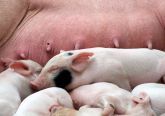Effect of Fusarium contamination in 1st parity sows

Researchers at the University of Guelph in Canada studied the effects of feeding diets naturally contaminated with Fusarium mycotoxins on protein metabolism in late gestation and lactation of first parity sows.
A study was conducted to assess the effects of feeding a blend of grains naturally contaminated with Fusarium mycotoxins to sows on the capacity for protein synthesis in skeletal muscle, the protein content per cellular unit, and the efficacy of a polymeric glucomannan adsorbent (GMA) to prevent these effects in late gestation and in lactation.
Thirty-two Yorkshire sows were assigned to 4 treatment groups (8 per treatment) from 91 +/- 3 d of gestation up to weaning on d 21 after farrowing. Diets included, (1) control, (2) contaminated grains, and (3) contaminated grains + 0.2% GMA. A fourth treatment of feeding sows the control diet at a restricted feed allowance was also included. The variables measured include ADFI, average daily BW change, serum total protein, urea, and ammonia, and skeletal muscle DNA, RNA, and protein. To assess the capacity for protein synthesis, ratios of RNA:DNA, and RNA:protein were compared among dietary treatments.
To assess the degree of muscle protein mobilization in both gestation and lactation, ratios of protein:DNA were compared among dietary treatments. Muscle samples were obtained from the triceps brachii. Blood and muscle samples were obtained 3 times: the first was obtained 1 d before the sows began to receive the experimental diets (90 +/- 3 d of gestation), a 2(nd) sample was obtained 14 d later (104 +/- 3 d of gestation), and the 3(rd) sample was obtained 10 d after farrowing.
Serum ammonia concentrations were similar in sows fed the contaminated feed and sows fed the restricted feed compared to controls, but serum ammonia concentrations were greater in sows fed contaminated feed (P = 0.02) and restricted-fed sows (P = 0.008) compared to sows fed the contaminated grains plus GMA on 104 +/- 3 d of gestation. There were no reductions in the capacity for protein synthesis caused by mycotoxins or restricted feeding compared to controls.
A reduction in ADFI (P = 0.003) was observed in sows fed the 2 contaminated diets in lactation. Muscle protein mobilization was not affected by diet, but a reduction (P = 0.04) in the content of protein per cellular unit was observed in lactation compared to gestation. Reduction in protein:DNA could be caused by the catabolic state in lactation, which was augmented by a low ADFI. The rate of muscle mobilization could be the result of the indirect effect of the reduction in ADFI in lactation rather than a direct effect of Fusarium mycotoxins in the capacity for protein synthesis.
This paper was published in the Journal of Animal Science (2009)











